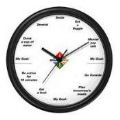On any given day, it seems there are a million and one things to get done. There are phone calls to be made, meals to be prepped, errands to be run, appointments to make or break. All of them tumble around in your brain, niggling and nudging until it’s their turn for your attention. But inevitably, one of them will get trampled by the others, never to be heard from again—until you're reminded of it by someone else (likely not in a pleasant manner).
As amazing as your mind might be, it’s probably not the best place to store your tasks. To make sure nothing gets lost in the shuffle, many people record and track their tasks in a physical, permanent place—the old-fashioned to-do list.
According to Karen Koenig, to-do lists work for best for task-oriented folks who thrive on meeting small goals. "To-do lists are especially helpful for visual people who take comfort in seeing items crossed off a list, because it makes them see what they’ve accomplished," she says.
When you put an action item on a to-do list, it moves the item out of your head and onto the paper (or screen, or board). As licensed clinical counselor Lisa Bahar notes, this helps to decrease ruminating thoughts and feelings of being overwhelmed. For people who have trouble staying focused and managing their time, a list can help them stay organized and increase productivity.
"The key is to allow a reasonable amount of time to complete the task, [and] not to shame yourself for not getting the task done," says Bahar. "It can also boost self-esteem, as there is a sense of closure and accomplishment as tasks are completed, which can create a sense of meaning and purpose."
7 Tips for Effectively Using To-Do Lists
1. Find the format that’s right for you.
Each person has their own preference for what type of to-do list best complements their personality and work style. As Bahar notes, some like electronic use of devices and are more inclined to use their computer, phone or tablet. Others prefer physical planners and some like stickers and more decorative approaches. Maybe a whiteboard or desktop calendar is more your speed.
"The goal is to figure out what kind of planner you will be and then start building on that method," Bahar says. "This may take some trial and error before you find out what works for you."
2. Map out the week.
Life transitions coach Miriam Amselem suggests creating a to-do list each Sunday evening to help navigate the week ahead—a practice she calls "week mapping." She starts by writing things down in no particular order—calls to make, appointments to schedule, rooms to organize—and then assigns the tasks to specific days.
Similarly, Dr. Koenig suggests organizing tasks by category, such as phone calls, household chores, workobligations, errands and other groupings, to help you tackle similar items more efficiently.
3. Tailor the list to your priorities.
To create an effective to-do list, Pam Sherman of The Perfect Balance Guru says it’s crucial to look at what is really important to you. Is it your health? If so, what are your three biggest struggles? For example, you might make a list to remind yourself to "1) drink more water, 2) add a veggie at each meal and 3) set your alarm to go to bed (and turn off Netflix!)."
If your priority is to find more time in your day for health and fitness, your to-do list might include things like waking up 15 minutes early to meditate, going on a walk during lunch or taking a yoga class after work.
4. Don’t make the list too long.
If a list goes on and on with no end in sight, it can easily become overwhelming, warns Sherman. "I always advise clients to write a list of no more than three things on a sticky note every day," she says. "This way, they can accomplish what is really important to them."
5. Allocate time for communication.
Checking emails, returning phone calls and answering texts can easily turn into time-suckers, warns Amselem. She recommends designating a certain amount of time for those activities. Skip this step and those small but necessary tasks could derail your list with their constant distractions.
6. Be specific.
If to-do items are too broad or general, they may seem overwhelming and it may be difficult to summon the motivation to get started. Aim for smaller, more specific tasks that are easier to tackle. For example, instead of "Exercise today," you might add "Take a 10-minute walk, do 10 pushups and stretch for 10 minutes."
"Once you get started, you might find that you go over and above," Sherman says. "Shoot for a doable to-do list, accomplish this for a week or so and then you can add bigger things."
|




.png)



.jpeg)